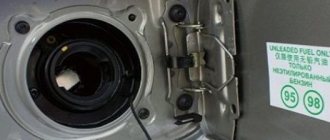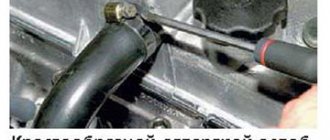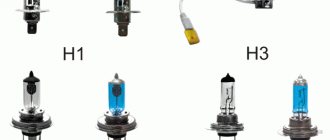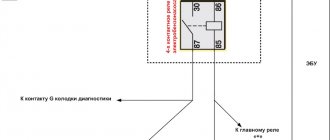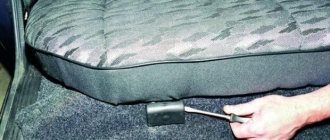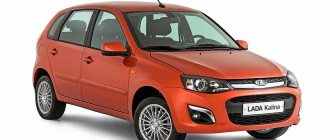In November 2004, the first series of the Lada Kalina people's car came off the assembly line of the AvtoVAZ concern. According to some reports, the first samples of small-scale production appeared on the market back in 1998. When production was established, the car began to be equipped in three body types: a 5-door hatchback and a sedan, and later a station wagon. The manufacturer's data indicates that the fuel consumption of the Lada Kalina is at an average level, which is confirmed by numerous reviews from owners. Subsequently, both the body and the power unit of this car were modernized, and today the second series of LADA Kalina is being produced.
Official data on gasoline consumption
There are two series of cars and several more of their modifications; data on gasoline consumption of the Lada Kalina differ somewhat, depending on the installed engine and body type. Typically, a station wagon consumes more gas than a hatchback or sedan due to the vehicle's greater weight. However, according to the manufacturer, there may be a slight difference in consumption even between a hatchback and a sedan of the same series, modification and year of manufacture.
In theory, the Lada Kalina has an average gasoline consumption for a 1.4 liter engine of about 9.6 liters. in the city and up to 6.3 l. when driving on an open road. Naturally, each modification has its own characteristics, parameters and technical characteristics; we will consider below exactly how this affects the fuel consumption of the Lada Kalina.
Conclusion
In its price category, Lada-Kalina has no equal in terms of functionality. After all, the top version with ABS, sound insulation, electric windows, and heated front seats costs about 500,000 rubles. The Kalina engine consumes a minimal amount of oil. A new one has been added to the engine range.
Fuel consumption per 100 km for the Lada Kalina is 7.1 liters in the combined cycle. A car with similar functionality will cost two or even three times more. It is easier for a buyer living in Russia to buy a Kalina than a foreign car, since consumables, components and maintenance are as affordable as possible.
Source
First generation
The first sedan car went on sale in 2004; the car was equipped with a 1.4 liter engine with 89 horsepower. Fuel consumption of Lada Kalina 1118 (factory designation) had the following values:
- City - 9.6 l. per 100 km.
- Route – 6.3 l. per 100 km.
- Mixed pace - 7.8 l. per 100 km.
It should be noted that in 2009 the production of the first generation of LADA Kalina sedans was suspended, but within a few months the cycle was established, and until 2011 this model was produced by the AvtoVAZ concern.
Hatchbacks went on sale a little later, towards the end of 2006, and then production of the Lada Kalina (1119) was launched. These cars, as well as sedans, began to be equipped with a more powerful engine, which had a 1.6 liter fuel compartment and was produced with a power of 81 hp and 98 hp. According to the requests of the factory developers, which corresponded to the reviews of the owners, the car with an 81-horsepower engine had the following fuel consumption indicators per hundred kilometers:
- City - 10.2 l.
- Route – 6.6 l.
- Mixed temp – 7.4 l.
As for the 98 horsepower engine, the consumption per hundred kilometers of road under different conditions is:
- City - 9.7 l.
- Route – 6.4 l.
- Mixed temp – 7.1 l.
Only in 2007, the automobile concern rolled out the Lada Kalina with a station wagon (1117), its fuel consumption parameters are approximately the same as those of cars in other bodies, except that when driving in the city it consumes 200-300 grams. more gasoline.
One of the branches produced in limited series was the LADA Kalina Sport (11196), this car was released in 2008. Her gasoline consumption figures per 100 km are:
- City - 9.4 l.
- Route – 6.7 l.
- Mixed pace - 8.9 l.
Like the entire first series, LADA Kalina Sport ceased production in mid-2013.
Real data, according to owner reviews
- Victor, Saratov. I've been driving this car for a long time, everything has happened, except serious accidents, and I've gotten to know the car well. There are weaknesses in the body; the front arches began to rot especially quickly. But the engine is reliable, provided of course you use high-quality gasoline, oil and coolant. Lada Kalina with a 1.4 liter 16-valve engine has average fuel consumption. I drive mostly around the city and, as before, I pour ten liters per hundred kilometers in heavy traffic.
- Sergey, St. Petersburg. I bought a Kalina hatchback for maneuverable driving around the city while working. In 2010, I made a choice in favor of the 1.6 liter 16 valve version, and I think it was right. The car is really nimble, and the fuel consumption on this Kalina is even lower than on its less powerful brothers in the shop. Of course, very often you have to get stuck in traffic jams, so the figure of 11 liters per 100 km does not seem significant.
- Stepan, Ufa. I bought a good station wagon from the domestic auto industry first-hand in 2013; at that time the car was in good condition, although the struts were already knocking. During operation, everything else began to crumble, including the engine. The workshop said that I often filled with low-quality fuel, this seems to be true, the gas station near my house does not belong to any of the well-known networks. Kalina's consumption per 100 km is approximately 11-12 liters in the city, but on the highway maybe a little less, I didn't measure it.
- Yaroslav, Kazan. I live on the outskirts of the city and my work is shift work, so I can avoid major traffic jams and get to my destination with minimal fuel loss. Therefore, my sedan’s fuel consumption per hundred kilometers is slightly less than 9 liters. Otherwise, I am also completely satisfied with the Lada Kalina; she feels confident both off-road and on high-speed sections of the highway.
- Alexander, Konstantinovka. Buying a 1.6 liter Lada Kalina. and 8 valves, was not the best investment. I was guided then by the advice of my comrades, they say, this motor is the most reliable. In fact, the breakdowns were not long in coming, although they were minor, but I think others fail just as often. But the gasoline consumption of a car with such an engine is the highest; it simply does not have enough power to gain speed confidently. So it turns out that even on the highway she eats at least 9 liters per hundred square meters.
Reviews about fuel consumption of Lada Kalina 2, 106 hp.
- Farhad, Kislovodsk. I saw a Lada Kalina 2 in the cross-country version in the showroom - I immediately liked it, I really took a liking to it. Naturally, I bought it. 106 horsepower engine, interior color matched to the body - everything you need. Consumption is 10 liters in the city - but I heat it normally, I like the way the engine behaves.
- Pavel, Belgorod. Before that, I already had a Kalina, with a 1.4 liter engine - I bought it in 2008. In 2021 I decided to sell and take the new Kalina 2, but not a sedan, but a station wagon. I had my eye on an excellent option with a new 16-valve 106-horsepower engine from Renault - I was pleasantly surprised by the engine. The power has really increased, but the consumption has remained approximately the same - my computer shows 7.8..8.0 l/100 km.
- Eldar, Kaminsk-Shakhtinsk. Kalina 2, 2021, engine 106 hp, mechanics. The car from the showroom - I hope there will be no problems for the next couple of years. There is enough space in it (I have a station wagon), the engine is nimble, although noisy. In terms of consumption, my average consumption is about 8 liters per 100 km, in winter up to 9.5.
- Mikhail, Serpukhov. This is already the third domestic car - before that there was Oka and Kalina 2006. Just when she left, I decided to buy a new car. Since Kalina suited me, I chose it, but with a 1.6MT 106 hp engine. – the old 8-valve engine is not enough. The consumption of the Renovo engine is the same as that of an 8-valve engine - up to 10 liters in the city, but the power is 20 more horses.
- Maxim, Nizhny Tagil. Since 2005, I drove a seven-year-old Nine. When I bought Kalina 2, it was like I was getting into a cool foreign car. Then, of course, bugs came out, but that’s not what we’re talking about. Economical - 10 liters in the city with a 106 horsepower engine, comfortable and there are a bunch of all sorts of fake whistles, from ABS and power windows to climate control.
New Lada: VAZ Vesta 2021 owner reviews: all the cons, disadvantages, pros
Second generation
Since 2013, the Lada Kalina car line has been updated and new cars have entered the market. Among them was not the usual sedan, with which the series began production, but the production of 5-door hatchbacks and station wagons continued. Fuel consumption on the new Lada Kalina has been reduced, but the manufacturer's requests do not always correspond to customer reviews.
The second Kalina came with two types of engines, each with a volume of 1.6 liters, but their power differed. There was also a choice of transmission options; as before, it was possible to purchase a car with a manual 5-speed gearbox or with a 4-speed automatic. A new feature was the entry into the arena of a 5-speed robotic transmission.
The power units installed on the Lada Kalina 2 had the following fuel consumption:
- VAZ-21126 - 98-horsepower engine, 1.6 liter capacity. with four cylinders and 16 valves, it was equipped with a distributed fuel injection system. Gasoline consumption figures in the city are 9.9 liters, on the highway 6.5 liters.
- VAZ-21127 - had 106 hp at its disposal. And fuel consumption on a free road was 5.8 liters, in urban driving it was 8.4 liters. Gasoline was also supplied by distributed injection.
Owners about consumption on Kalina 2
- Peter, Tyumen. I bought a Lada Kalina Cross in 2015. This is one of the few representatives of the domestic automobile industry with horsepower exceeding one hundred. And indeed the car turned out to be lively; my hatchback can compete with some foreign cars when driving on open sections of the road. The other side of the coin is gasoline consumption in the city; I did not observe the promised 8.4 liters both during the run-in and after it. This engine consumes at least 10 liters per 100 km of road with traffic jams.
- Lev, Voronezh. My wife does not know how to use a manual transmission, so I had to buy a car with an automatic transmission system. The choice fell on the second generation Lada Kalina 2014. Naturally, I understood that, as with any automatic, fuel consumption would be higher than with a manual, and that’s what happened. My figures in the city, judging by the on-board computer data, are usually within the range of 11-12.5 liters per 100 km of traffic. This sad moment worsened three years after the purchase, the injector with nozzles became clogged, for some reason this happens more often on the 8-valve Kalina than on other engines.
- Taras. Moscow. I never regretted buying Kalina Cross for my baby; she often helped me out in situations when more expensive foreign cars failed. And when breakdowns happened, and this happens, the repairs did not cost me much at all. Of course, it cannot be considered a plus that the Lada Kalina has fuel consumption per 100 km, with a power of 106 hp. higher than foreign cars of the same class. In my case, in the city, I fill at the rate of 12 liters, but on the highway the situation changes dramatically and costs drop to 7.5 liters.
- Ilya, Odessa. For a car with such a price, many disadvantages are forgiven, but they exist. First of all, this is the fuel consumption of the Kalina; it can sometimes be compared with the performance of some SUVs. Regular failure of components and parts is also somewhat annoying, but the main thing for me is road noise. Compared to foreign cars, you feel as if you are driving without doors. Of course, there are also advantages: it is inexpensive to service and parts are always easily accessible.
- Andrey, Nakhabino. I don’t understand why people have so much hatred for the Lada Kalina, because you can find out everything about it before buying, and there are plenty of disadvantages, but there are also advantages. Mostly they complain about high gasoline consumption, but you can always install LPG and save money. The metal on the body is good and thick, its quality cannot be compared with Chinese tins. It’s just a pity that the quality of the factory paint is rather weak, and over the years bubbles appear in some places.
Official data (l/100 km)
| Engine | Consumption (city) | Consumption (highway) | Flow (mixed) |
| 1.4 MT 89 hp (Mechanics) | 8.3 | 6.0 | 7.0 |
| 1.6 MT 81 hp (Mechanics) | 9.8 | 6.1 | 7.8 |
| 1.6 MT 90 hp (Mechanics) | 9.8 | 6.1 | 7.2 |
| 1.6 MT 98 hp (Mechanics) | 9.4 | 5.8 | 7.2 |
| 1.6 MT 98 hp (machine) | 9.9 | 6.1 | 7.6 |
| 1.6 MT 106 hp (Mechanics) | 8.6 | 5.6 | 6.7 |
| 1.6 AMT 106 hp (robot) | 8.6 | 5.6 | 6.7 |
Reasons for high fuel consumption
It is believed that Kalina’s consumption of gasoline, high fuel consumption, has objective reasons, but this is not always the case. There are situations in which the owner himself is to blame for increased fuel costs, among them:
- Aggressive driving style - unreasonable acceleration on busy sections of the road, leads to increased costs, driving on the highway at the maximum speed for a car also causes unnecessary losses. On an open road, you should not exceed the cruising speed of 90-110 km/h.
- Untimely maintenance - failure or clogging of some components responsible for supplying gasoline to the combustion chamber leads to increased consumption. Wear of the piston system, like
- Viburnum, like other car brands, is also a common cause of high fuel costs. Poor quality fuel - you should not trust unverified gas stations, especially if they do not have known identification marks.
Based on the information provided, we can conclude that the Lada Kalina, like any other car, has a number of disadvantages, but it also has advantages, so you should weigh the pros and cons before purchasing.

